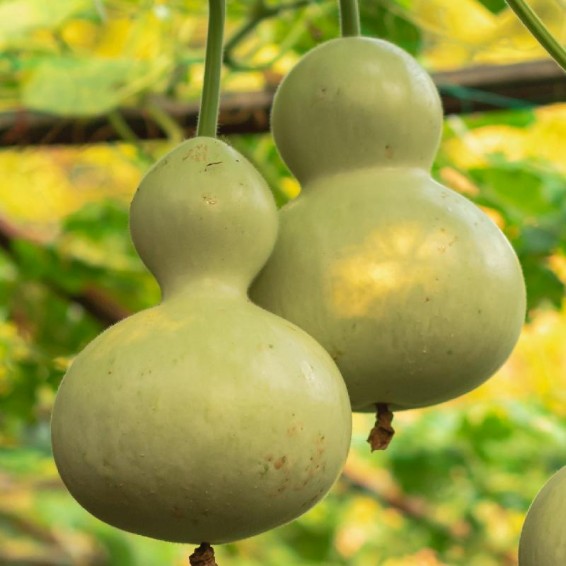Organic Birdhouse Bottle Gourd Seeds
- HOW TO GROW
- FAST FACTS
- REVIEWS
HOW TO GROW
Sowing: In shorter growing seasons, start gourd seeds indoors in peat pots 3-4 weeks before the last frost. To speed germination, soak the seeds overnight. Plant the seedlings outdoors in rich soil and full sun after the last spring frost. For direct sowing, wait until the soil warms to 70 degrees F, then plant 5 seeds per hill, 1" deep, with 5' spacing; later, thin to the strongest plant.
Growing: Keep the soil evenly moist. When the vines begin to develop, either provide a trellis or lay down mulch to keep the gourds from contact with the soil; too much soil contact can weaken the shell, distort the shape, and cause rotting.
Harvesting: Late in the summer, the stem and leaves of the gourd will wither and turn brown; cut off the gourd, leaving about 2" of stem. Wash it with a solution of white vinegar and water to deter mold. Place them in a warm, dry location on a screen so that every side of the gourd has good air circulation. If the gourd begins to rot and shrivel up, throw it away; surface mold is normal. Bottle gourds may take a month or more to dry, depending on the size. When completely dry, they will be extremely lightweight and the seeds will rattle inside. If using them for birdhouses or other containers, some of the cutting may have to take place before the gourd is completely dry.
Seed Saving: After the gourds have completely dried so that the seeds inside rattle, remove the seed by cutting open the gourd or drilling a hole in the shell. Spread out the seeds to dry; when a seed will snap in two, it has dried sufficiently. If the seed only bends but will not break, further drying time is needed. Store the dry seeds in a cool, dry place for up to six years.
FAST FACTS
Latin Name: Lagenaria siceraria
Type: Open Pollinated, Warm Season
USDA Zones: 4, 5, 6, 7, 8, 9, 10, 11, 12
Seeds per Ounce: 144
Planting Method: Direct Sow
Sunlight: Full Sun
Height: 12 Inches
Color: Green, Brown
Only 4 seeds came up
Very disappointed, only 4 seeds came up.
DESCRIPTION
HOW TO GROW
Sowing: In shorter growing seasons, start gourd seeds indoors in peat pots 3-4 weeks before the last frost. To speed germination, soak the seeds overnight. Plant the seedlings outdoors in rich soil and full sun after the last spring frost. For direct sowing, wait until the soil warms to 70 degrees F, then plant 5 seeds per hill, 1" deep, with 5' spacing; later, thin to the strongest plant.
Growing: Keep the soil evenly moist. When the vines begin to develop, either provide a trellis or lay down mulch to keep the gourds from contact with the soil; too much soil contact can weaken the shell, distort the shape, and cause rotting.
Harvesting: Late in the summer, the stem and leaves of the gourd will wither and turn brown; cut off the gourd, leaving about 2" of stem. Wash it with a solution of white vinegar and water to deter mold. Place them in a warm, dry location on a screen so that every side of the gourd has good air circulation. If the gourd begins to rot and shrivel up, throw it away; surface mold is normal. Bottle gourds may take a month or more to dry, depending on the size. When completely dry, they will be extremely lightweight and the seeds will rattle inside. If using them for birdhouses or other containers, some of the cutting may have to take place before the gourd is completely dry.
Seed Saving: After the gourds have completely dried so that the seeds inside rattle, remove the seed by cutting open the gourd or drilling a hole in the shell. Spread out the seeds to dry; when a seed will snap in two, it has dried sufficiently. If the seed only bends but will not break, further drying time is needed. Store the dry seeds in a cool, dry place for up to six years.
FAST FACTS
Latin Name: Lagenaria siceraria
Type: Open Pollinated, Warm Season
USDA Zones: 4, 5, 6, 7, 8, 9, 10, 11, 12
Seeds per Ounce: 144
Planting Method: Direct Sow
Sunlight: Full Sun
Height: 12 Inches
Color: Green, Brown
Reviews
Review
Only 4 seeds came up
Very disappointed, only 4 seeds came up.





